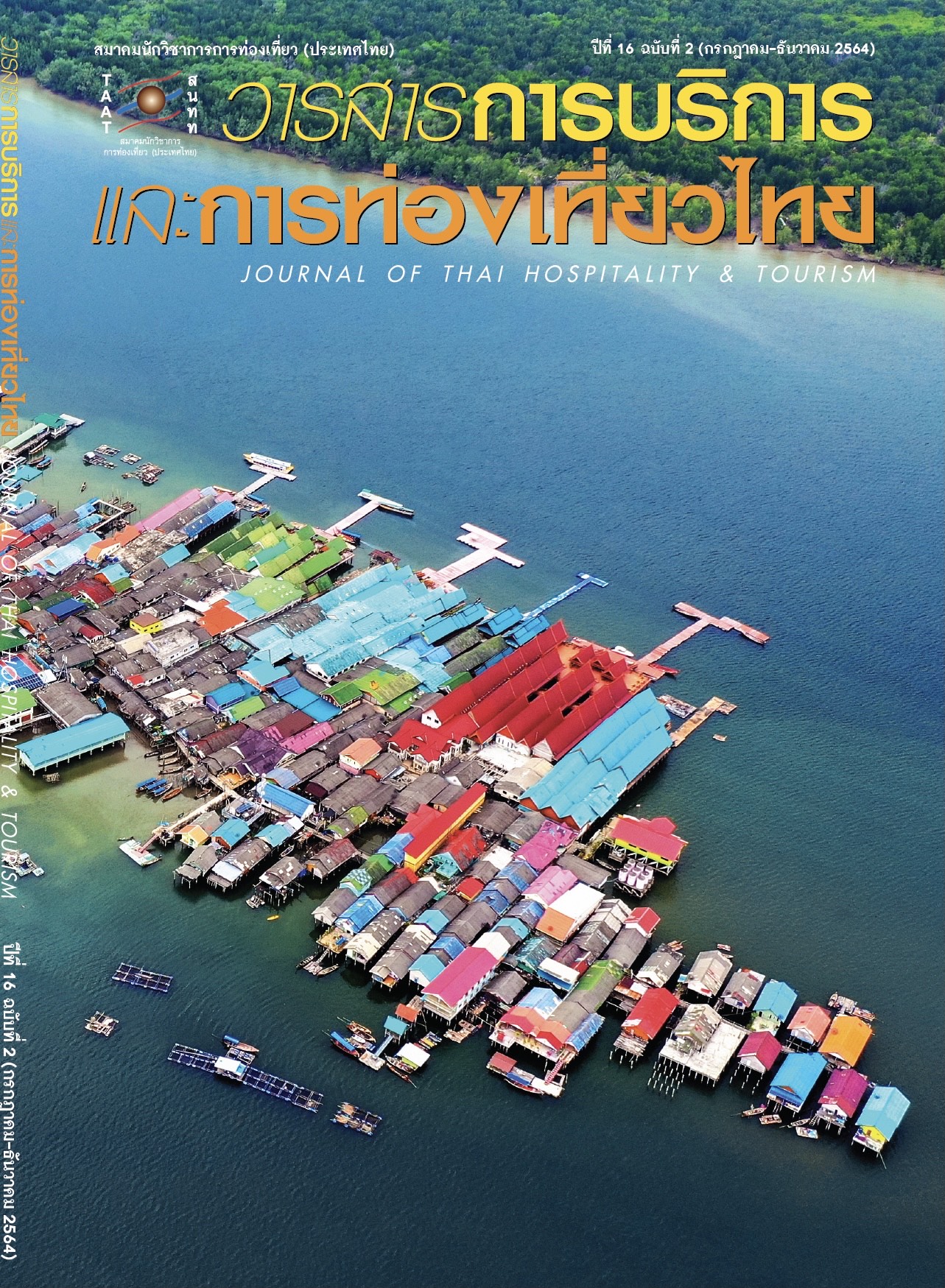Innovation for Survival: A Case Study on Cassia’s Alternative Accommodation Model Amidst the Rise of the Sharing Economy
Main Article Content
Abstract
The establishment of Airbnb in 2008 was a bell warning of the threats that existing hotel players would face from new entrants. This case study focuses on Banyan Tree’s innovative new brand Cassia. In this case, a combination of primary and secondary data were used for research analysis, including an interview with Cassia Phuket’s key executive, and extensive secondary research on Banyan Tree’s strategy which led to innovations on and within Cassia Phuket. The focus of this study is to illustrate the innovative solutions and options that hotel players could adopt to tackle the disruptive innovation by competitors. It also illuminated how innovation as a tool could help companies to be better sharpen and adapted for survival in the future market.
Article Details
References
Adam, J. & Khan, H. (2007). Research Methods for Graduate Business and Social Science Students. New Delhi: Sage Publications.
Bank of Thailand. (2018). Tourism Indicators. Retrieved from http://www2.bot.or.th/statistics/ReportPage.aspx?reportID=875&language=eng
Banyan Tree Holdings Limited. (2015). Annual Report 2014 A Journey of Transformation. Retrieved from http://media.corporate-ir.net/media_files/IROL/20/200797/BTH_AR2014_SGX.PDF
Barnett, B. (2015). Phuket 2015 Hotel Market Update. Phuket: C9 Hotelworks Company Limited.
Chen, W. J. (2011). Innovation in Hotel Services: Culture and Personality. International Journal of Hospitality Management, 30(1), 64–72.
Creswell, J. (2014). Research Design. London: Sage Publications.
Damanpour, F., Walker, R. M. & Avellaneda, C. N. (2009). Combinative Effects of Innovation Types and Organizational Performance: A Longitudinal Study of Service Organizations. Journal of Management Studies, 46(4), 650–675.
Dawson, C. P. & Brown, T. L. (1988). B&Bs: A Matter of Choice. The Cornell Hotel and Restaurant Administration Quarterly, 29(1), 17–21.
Drejer, I. (2004). Identifying Innovation in Surveys of Services: A Schumpeterian Perspective. Research Policy, 33(3), 551–562.
Elo, S., Kääriäinen, M., Kanste, O., Pölkki, T., Utriainen, K., & Kyngäs, H. (2014). Qualitative Content Analysis. A Focus on Trustworthiness, 4(1), 1-10.
Enz, C. A. & Harrison, J. S. (2009). Hospitality Strategic Management: Concepts and Cases. New Jersey: Wiley.
Euromonitor International. (2015). Lodging in Thailand. Retrieved from http://www.euromonitor.com/travel-accommodation
Farmaki, A., Altinay, L., Botterill, D. & Hilke, S. (2015). Politics and Sustainable Tourism: the Case of Cyprus. Tourism Management, 47, 178–190.
Fletcher, J., Fyall, A., Gilbert, D. & Wanhill, S. (2013). Tourism Principles and Practice. Harlow: Pearson.
Gunasekaran, N. & Anandkumar, S. V. (2012). Factors of Influence in Choosing Alternative Accommodation: A Study with Reference to Pondicherry, A Coastal Heritage Town. Procedia–Social and Behavioral Sciences, 62, 1127–1132.
Gunasekaran, N., Peter, S., George, J. & Anandkumar, S. V. (2012). Alternative Accommodation Market in Pondicherry: A Study of Tourists’ Expectations and Experiences Using SERVQUAL. International Journal of Management, 3(3), 8–16.
Guttentag, D. (2013). Airbnb: Disruptive Innovation and the Rise of An Informal Tourism Accommodation Sector. Tourism, 1–26.
Ho, K. P. (2014). The Banyan Tree Group’s Cassia Brand. Singapore: Edipresse Media Asia.
Hooi, J. (2011). Innovation – the Way Ho Kwon Ping Sees It. Retrieved from http://www.asiaone.com/print/News/Latest%2BNews/Business/Story/A1Story20111024-306719.html
Kim, W. C. & Mauborgne, R. (2004). Blue Ocean Strategy. Harvard Business Review, (October), 76–84.
Lam, A. (2015). Banyan Tree Diversifies with Cassia Homes. Retrieved from http://marketing-interactive.com
Mandelbaum, A. (2015). How Virtual Reality Can Help Hotels Compete with Airbnb. Retrieved from http://www.eHotelier.com
Martĺnez-Ros, E. & Orfila-Sintes, F. (2009). Innovation Activity in the Hotel Industry. Technovation, 29(9), 632–641.
Mattsson, J. & Orfila‐Sintes, F. (2014). Hotel Innovation and Its Effect on Business Performance. International Journal of Tourism Research, 16(4), 388–398.
MIT Sloan Executive Education. (2014). How Should Hotels Respond To The Sharing Economy? Retrieved from http://executive.mit.edu/blog/how-should-hotels-respond-to-the-sharing-economy#.VsplAfl9670.
Mullins, L. & Christy, G. ( 2011). Essentials of Organizational Behaviour. Harlow: Pearson.
Orfila-Sintes, F., & Mattsson, J. (2009). Innovation Behavior in the Hotel Industry. Omega, 37(2), 380–394.
Porter, M. E. (1979). How Competitive Forces Shape Strategy. Palgrave: London.
Radder, L. & Wang, Y. (2006). Dimensions of Guest House Service: Managers’ Perceptions and Business Travellers’ Expectation. International Journal of Contemporary Hospitality Management, 18(7), 554–562.
Strong, C. (2014). Airbnb and Hotels: What to Do About the Sharing Economy? Retrieved from https://www.wired.com/insights/2014/11/hotels–sharing–economy
Sundbo, J. & Gallouj, F. (2000). Innovation as a Loosely Coupled System in Services. International Journal of Services Technology and Management, 1(1), 15–36.
TAT. (2015). Tourist Statistics–by Province. Retrieved from http://marketingdatabase.tat.or.th/ewt_w3c/ewt_news.php?nid=1621
Tidd, J. & Bessant, J. (2009). Managing Innovation: Integrating Technological, Market and Organizational Change. West Sussex: John Wiley and Sons Ltd.
Tseng, C. Y., Kuo, H. Y. & Chou, S. S. (2008). Configuration of Innovation and Performance in the Service Industry: Evidence from the Taiwanese Hotel Industry. The Service Industries Journal, 28(7), 1015–1028.
Walliman, N. (2011). Your Research Project Designing and Planning Your Work. London: Sage Publications.
Watkins, E. (2014). Hoteliers react to Sharing-Economy Competition. Retrieved from http://www.hotelnewsnow.com/Article/14348/Hoteliers-react-to-sharing-economy-competition
WTTC. (2015). Travel & Tourism Economic Impact 2015 World. Retrieved from http://www.wttc.org/-/media/files/reports/economic%20impact%20research/regional%202015/world2015.pdf
Yin, R. K. (2009). Case Study Research: Design and Methods. Thousand Oaks, CA: Sage.


